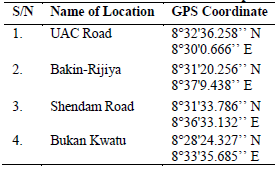Morphological Identification of Endophytic Fungi of Tomato Plants (Solanum lycopersicum L.) in Lafia
DOI:
https://doi.org/10.62050/fscp2024.490Keywords:
Endophytes, Tomato, Morphological Identification, Distribution, FungiAbstract
Endophytic fungi are a diverse group of microorganisms that inhabit the internal tissues of plants without causing immediate harm. A study was carried out to isolate, identify and determine the distribution of endophytic fungi in tissues of tomato plants in Lafia. Tissue segments of tomato plant samples about 2 cm2 in size were surface sterilized in 70% ethanol for 2 min, followed 1% sodium hypochlorite for 2 min, and plated on potato dextrose agar (PDA) for three days for the emergence of endophytic fungi. Endophytic fungi were morphologically identified through observation of their macro and micromorphological chracteristics. A total of 15 isolates were identified, two isolates each (20%) belonging to C. rosea, A. niger, P. corticola, A. flavus, and M. ruber, while one isolate each (10%) of A. viridistratum, A. calidoustus, Fusarium sp., Penicillium sp., and Aspergillus sp. were recovered. OmbiAnzaku had the highest number of isolates 6(40.00%), comprising one isolate of A. viridistratum (6.67%), two isolates of A. niger (13.33%), and one isolate each (6.67%) of A. calidoustus, Fusarium sp., and Penicillium sp., followed by Akoko with 5 isolates (33.33%), comprising two A. flavus (13.33%), one Aspergillus sp. (6.67%), and two M. ruber (13.33%). Bakinrijiya and Bukan Kwato had two isolates each (13.33%), comprising P. corticola in Bakinrijiya, and C. rosea in Bukan Kwato. The identification of genera with known biocontrol, bioactive, and growth-promoting properties underscores the potential application of these fungi in sustainable agricultural practices.
References
Rodrigues, S. M., Takahashi, J. A., & Casela, C. R. (2009). Secondary metabolites from Colletotrichum species and their roles in pathogenicity and ecological interactions. Fungal Biology Reviews, 35(1), 1–17. https://doi.org/10.1016/j.fbr.2020.10.003.
Saikkonen, K., Saari, S., and Helander, M. (2010). Defensive mutualism between plants and endophytic fungi? Fungal Diversity, 41(1): 101-113. https://doi.org/10.1007/s13225-010-0023-7.
Suryanarayanan, T.S., Thirunavukkarasu, N., Govindarajulu, M.B., Sasse, F., Jansen, R., and Murali, T.S. (2009). Fungal endophytes and bioprospecting. Fungal Biology Reviews, 102(4), 486-493. https://doi.org/10.1016/f.fbr.2009.07.001.
Rodriguez, R.J., Henson, J., Van Volkenburgh, E., Hoy, M., Wright, L., Beckwith, F., Kim, Y., and Redman, R.S. (2008) Stress tolerance in plants via habitat- adapted symbiosis. ISME J 2: 404–416. DOI: https://doi.org/10.1038/ismej.2007.106.
Damm, U., Cannon, P.F., Woudenberg, J.H., and Crous, P.W. (2012). The Colletotrichum acutatum species complex. Stud Mycol., 15;73(1):37-113. doi: 10.3114/sim0010. PMID: 23136458; PMCID: PMC3458416.
Vleeshouwers, V.G., Raffaele, S., Vossen, J.H. et al. (2011). Understanding and exploiting late blight resistance in the age of effectors. Ann Rev Phytopathol., 49: 507–31. DOI: https://doi.org/10.1146/annurev-phyto-072910-095326.
Rybakova, D., Mancinelli, R., Wikström, M., Birch-Jensen, A.-S., Postma, J., Ehlers, R.-U., Goertz, S., and Berg, G. (2017). The structure of the Brassica napus seed microbiome is cultivar-dependent and affects the interactions of symbionts and pathogens. Microbiome, 5: 104. https://doi.org/10.1186/s40168-017-0310-6.
Zakaria, L., and Ning, C.H. (2013). Endophytic Fusarium spp. from roots of lawn grass (Axonopus compressus). Tropical Life Sciences Research, 24(2), 85. PMID: 24575251; PMCID: PMC3935371.
Schoch, C. L., Seifert, K. A., Huhndorf, S., Robert, V., Spouge, J. L., Levesque, C. A., Chen, W., and Fungal Barcoding Consortium; (2012). Nuclear ribosomal internal transcribed spacer (ITS) region as a universal DNA barcode marker for Fungi. Proceedings of the National Academy of Sciences, 109(16), 6241–6246. DOI: 10.1073/pnas.1117018109.
Terna, T.P., Mohamed Nor, N.M.I., Azuddin, N.F., and Zakaria, L. (2024). Molecular identification and pathogenicity of endophytic fungi from corn ears. Sci Rep. 14(1): 17146. https://doi.org/10.1038/s41598-024-68428-1.
Ma, X., Chomnunti, P., Doilom, M., Daranagama, D.A., and Kang, J. (2022). Multigene Phylogeny Revelas Endophytic Xylariales Novelties from Dendrobium species from Southwestern China and Northern Thailand. Journal of Fungi, 8: 248. https://doi.org/10.3390/jof8030248.
Lahlali, R., Ezrari, S., Radouane, N., Kenfaoui, J., Esmaeel, Q., El Hamas, H., Belabess, Z., and Barka, E.A. (2022). Biological control of plant pathogens: A global perspective. Microorganism, 10: 596. https://doi.org/10.390/microorganisms10030596.
Khan, S. A., Hussain, S., & Ali, S. (2020). Secondary metabolites of Aspergillus and Penicillium as biocontrol agents. Journal of Agricultural Research, 58(3), 233-246.
Akram, S., Ahmed, A., He, P., He, P., Liu, Y., Wu, Y., Munir, S., and He, Y. (2023). Uniting the role of endophytic fungi against plant pathogens and their interaction. Journal of Fungi, 9: 72. https://doi.org/10.3390/jof9010072.
Feng, S., Li, W., Hu, Y., Feng, J., and Deng, J. (2022). The biological activity and application of Monascus pigments: a mini review. International Journal of Food Engineering, 18(4): 253-266. https://doi.org/10.1515/ijfe-2021-0235.

Downloads
Published
Issue
Section
License
Copyright (c) 2025 Proceedings of the Faculty of Science Conferences

This work is licensed under a Creative Commons Attribution-NonCommercial-ShareAlike 4.0 International License.


